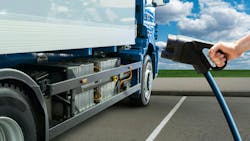It seems that there are a lot of very passionate voices on both sides of the battery-electric vehicle discussion. On the one side are those folks who insist diesel will always be a fuel for the majority of trucking applications and that switching to BEVs will always be too costly. On the other are those who think BEVs are not happening quickly enough. They see battery-electric trucks as the technology for every fleet and every duty cycle.
Most of the time, the best solution is somewhere in the middle. Today, BEVs are being used by a range of fleets, and in all of those cases, the trucks are returning to base to be charged. Many well-known fleets have moved past deploying one or two trucks to having multiple battery-electric trucks domiciled in one depot. Those trucks include terminal tractors, van and step vans, medium-duty box trucks, and in some cases, Class 8 tractors for short, regional haul. Where BEVs are not working is in long-haul applications.
Infrastructure is still a problem because there is no national charging network. Even for fleets doing depot charging, it is taking too much time to get infrastructure installed.
To be clear, diesel is going to be around for years, if not decades. However, its long-term future as a fuel for trucks is limited. Either federal and state emissions regulations will cause it to sunset, or OEMs will stop making diesel-powered vehicles because it will not make sense to invest in them when the majority of the market shifts to BEVs.
Of course, there are fleets on the leading—some would say bleeding—edge of BEV adoption. However, most fleets, including Transervice, are beginning to get their feet wet adding BEVs in limited qualities to see how they perform.
See also: Forget the carrot. EPA uses stick.
With any new technology, it can be difficult to separate the reality from the hype. However, it is critically important that fleets understand the reality of deploying BEVs, including the challenges involved.
Collaboration and partnerships make sense at this time. Fleets need to bring together a variety of voices to decide if, when, and in which applications it makes sense to move from diesel power to battery electric. The discussion on BEVs needs to include truck makers, dealers, local utilities, manufacturers of charging equipment, charge management firms, architects, contractors, etc.
What you want to do is start having preliminary discussions so you will understand the full scope of what it will take to add electric vehicles in small numbers and position yourself to add them in larger numbers seamlessly.
Now is the time to have these discussions before you order your first BEV so that when it arrives, you have enough power at your site to charge it.
The movement from diesel-powered trucks to BEVs is going to be gradual, but planning for that transition is essential. And that means avoiding the loud voices on opposite ends of the discussion to focus on the facts and realities so that your transition makes sense for your unique operation.
About the Author
Gino Fontana
Chief operating officer and executive vice president at Transervice Logistics Inc.
Gino Fontana, CTP, is COO and EVP at Transervice Logistics Inc. His operational expertise emphasizes cost savings, process efficiency and improvement, superior quality, and people management skills. He has more than 35 years of experience in the transportation and logistics industry with both operational and sales experience.
